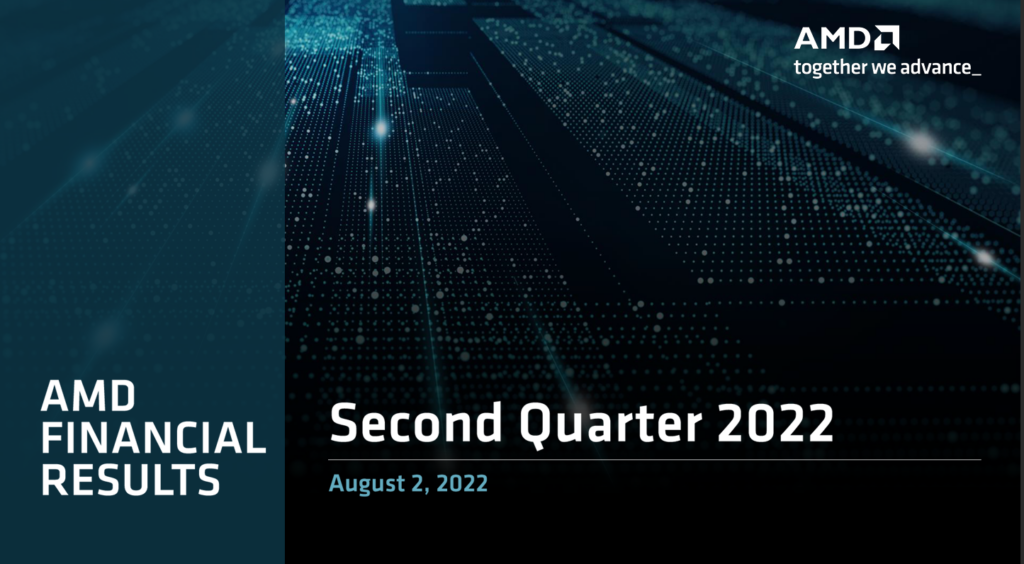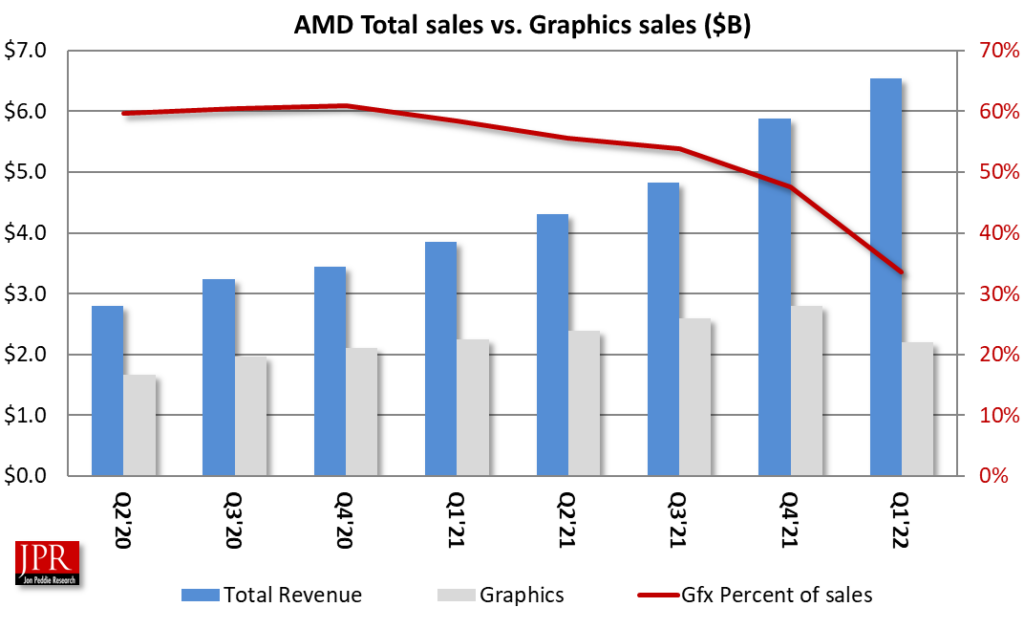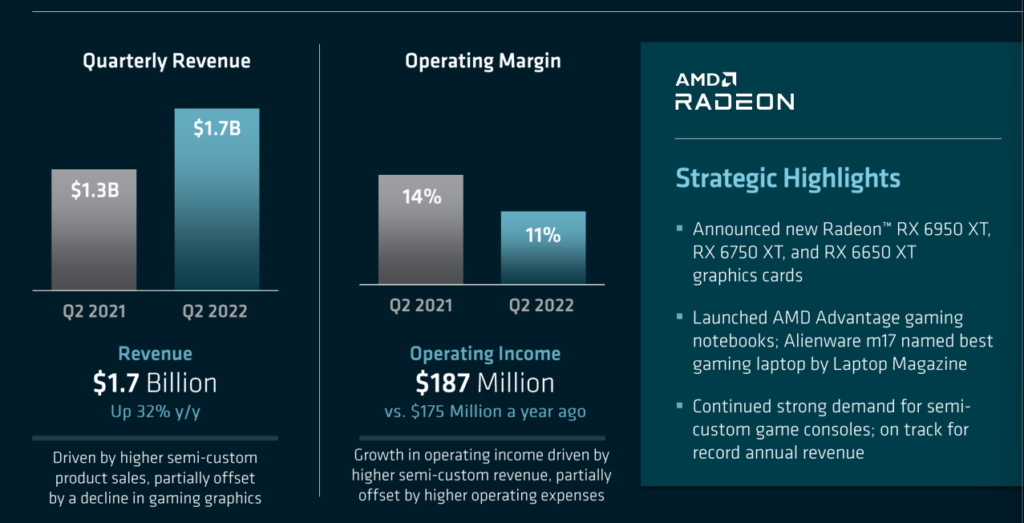Revenue up 11% from last quarter to $6.6 billion, profit down 43% Q/Q.

Unlike some of its competitors, AMD drove sales up in Q2 (above guidance and helped by Xilinx), although its expenses went up more, and margins and profit dropped.
“We delivered our eighth-straight quarter of record revenue based on our strong execution and expanded product portfolio,” said AMD Chair and CEO Lisa Su. “Each of our segments grew significantly year-over-year, led by higher sales of our data center and embedded products. We see continued growth in the back half of the year, highlighted by our next-generation 5 nm product shipments and supported by our diversified business model.”
Revenue of $6.6 billion increased 70% year-over-year driven by growth across all segments and the inclusion of Xilinx revenue.

Operating income was $526 million, or 8% of revenue, compared to $831 million, or 22%, a year ago, primarily due to amortization of intangible assets associated with the Xilinx acquisition. Record non-GAAP operating income was $2.0 billion, or 30% of revenue, up from $924 million, or 24%, a year ago, primarily driven by higher revenue and gross profit.
Net income was $447 million, compared to $710 million a year ago, primarily due to lower operating income. Record non-GAAP net income was $1.7 billion, up from $778 million a year ago, primarily driven by higher operating income.
Computing and graphics
Client segment revenue was $2.2 billion, up 25% year-over-year, driven by Ryzen mobile processor sales. Client processor ASP increased year-over-year, driven by a richer mix of Ryzen mobile processor sales. Operating income was $676 million, or 32% of revenue, compared to $538 million, or 31%, a year ago. Operating income improvement was primarily driven by higher revenue, partially offset by higher operating expenses.

Gaming segment revenue was $1.7 billion, up 32% year-over-year, driven by higher semi-custom product sales, partially offset by a decline in gaming graphics revenue. Operating income was $187 million, or 11% of revenue, compared to $175 million, or 14%, a year ago. Operating income improvement was primarily driven by higher revenue, partially offset by higher operating expenses. Operating margin was lower, primarily due to lower graphics revenue and higher operating expenses.

Data Center segment revenue was $1.5 billion, up 83% year-over-year, driven by strong sales of EPYC server processors. Operating income was $472 million, or 32% of revenue, compared to $204 million, or 25%, a year ago. Operating income improvement was primarily driven by higher revenue, partially offset by higher operating expenses.
AMD’s CDNA 3 graphics architecture featuring 3D die stacking, fourth-generation Infinity Architecture, next-generation AMD Infinity Cache technology, and HBM memory in a single package to power what are expected to be the world’s first data center APUs, AMD Instinct MI300 accelerators.
The AMD RDNA 3 next-generation graphics architecture is expected to deliver more than 50% greater performance per watt compared to the prior generation.
AMD completed the acquisition of Pensando Systems in a transaction valued at approximately $1.9 billion, to expand AMD’s data center product portfolio with a high-performance data processing unit (DPU) and software stack. Pensando DPUs are already deployed at scale across cloud and enterprise customers including Goldman Sachs, IBM Cloud, Microsoft Azure, and Oracle Cloud.
Margin
Gross margin was 46%, a decrease of 2 percentage points year-over-year, primarily due to amortization of intangible assets associated with the Xilinx acquisition. Non-GAAP gross margin was 54%, an increase of 6 percentage points year-over-year, primarily driven by higher Data Center and Embedded segment revenue.

Operating income was $526 million, or 8% of revenue, compared to $831 million, or 22%, a year ago, primarily due to amortization of intangible assets associated with the Xilinx acquisition. Record non-GAAP operating income was $2.0 billion, or 30% of revenue, up from $924 million, or 24%, a year ago, primarily driven by higher revenue and gross profit.
Net income was $447 million, compared to $710 million a year ago, primarily due to lower operating income. Record non-GAAP net income was $1.7 billion, up from $778 million a year ago, primarily driven by higher operating income.
Current outlook
AMD’s outlook statements are based on current expectations. The following statements are forward-looking, and actual results could differ materially depending on market conditions and the factors set forth under its published “Cautionary Statement.”
For the third quarter of 2022, AMD expects revenue to be approximately $6.7 billion, plus or minus $200 million, an increase of approximately 55% year-over-year, led by growth in the Data Center and Embedded segments. AMD expects the non-GAAP gross margin to be approximately 54% in the third quarter of 2022.
For the full-year 2022, AMD continues to expect revenue to be approximately $26.3 billion, plus or minus $300 million—an increase of approximately 60% over 2021, led by growth in the Data Center and Embedded segments. AMD continues to expect the non-GAAP gross margin to be approximately 54% for 2022.
What do we think?
The Frontier supercomputer, powered by AMD EPYC CPUs and AMD Instinct Accelerators, achieved number one spots on the latest Top500, Green500 and HPL-AI performance lists, an industry first, and was the first supercomputer to surpass the exaflop barrier. All of that adds to the overall credibility and confidence users and potential users have for the company.
The HPC industry continues to show rapidly growing preference for AMD solutions, with a 95% year-over-year increase in the number of AMD-powered systems on the Top500 list.
At AMD’s Financial Analyst Day meeting, Su hammered home the fact that AMD has gained scale, and with scale and cash reserves, the company can invest more and buy more. AMD’s R&D expenses in Q2’22 increased to $1.3 billion, the highest ever, and 23% higher than last quarter. That’s an example of scale, and it will pay off in the future.





